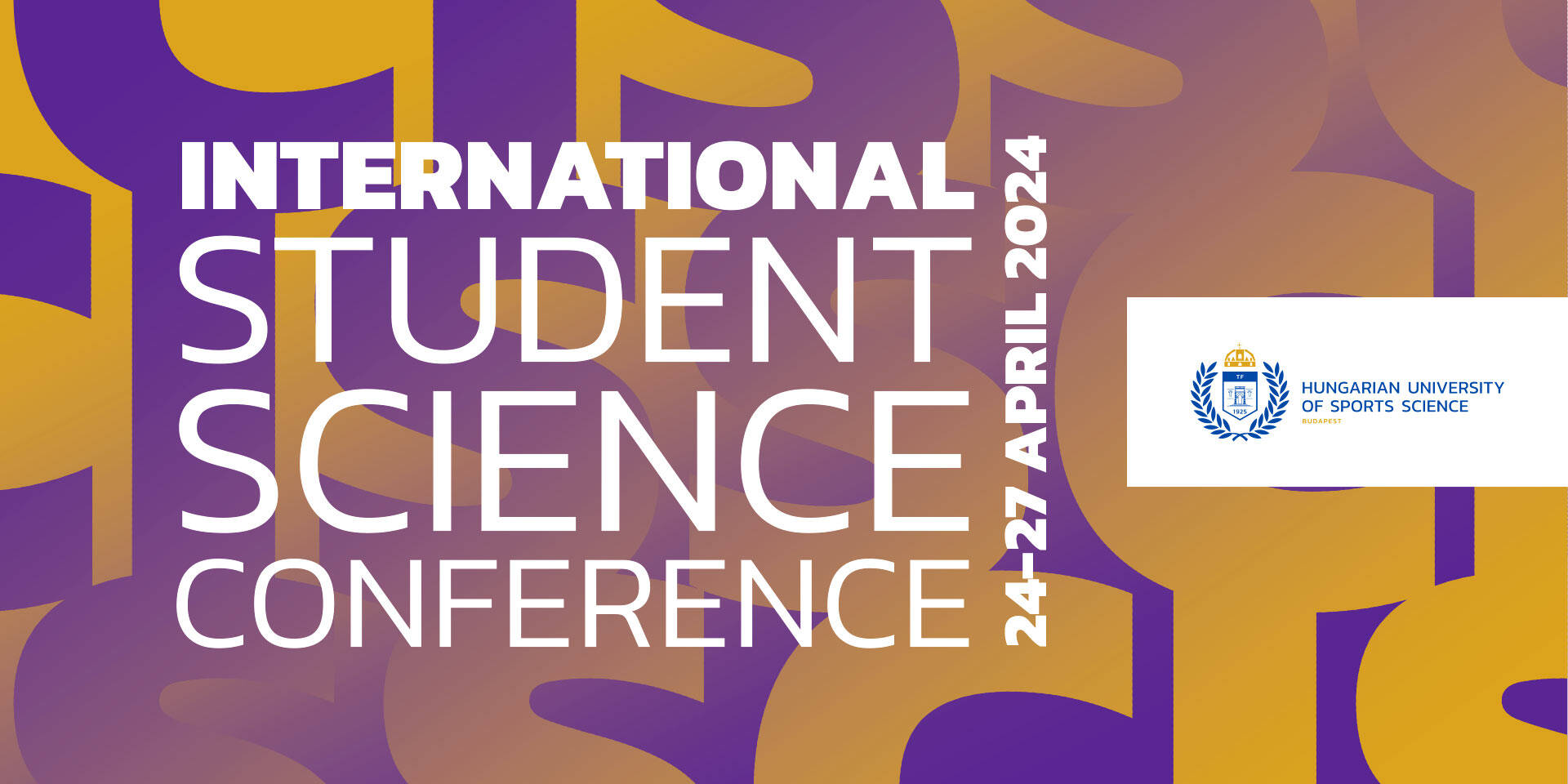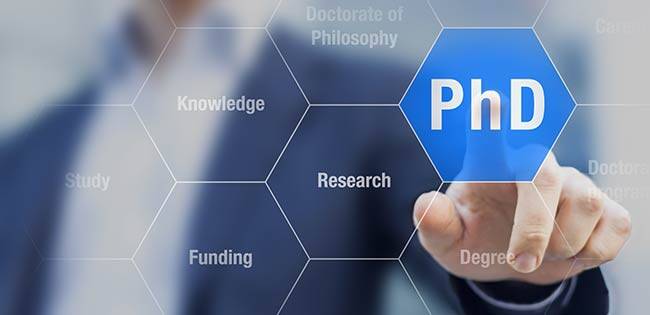Dear Student-researchers! It is my great pleasure to invite you - on behalf of the University of Physical Education - to participate at the 23rd International Student Conference on Sport Sciences (ISCSS-2018) in April 27, 2018. The conference will be held on the campus of our university, which is located close to the historical area of the city, on the hilly side of the beautiful Budapest, west to the Danube River.
It is a tradition of our University to bring together young student-researchers from UPE, and other Sport Institutions in Hungary and that of neighboring countries to present their results obtained in various fields of sportsciences. The ISCSS-2018 will provide valuable opportunities to exchange ideas, concepts and research findings, primarily by oral presentations. Also, it is our hope that the discussions will lead to future research collaborations and joint projects among the participants.
Previous participants can tell you about the great international spirit and vitality of these conferences and not to mention the fun they experienced in Budapest.
There will be plenary and invited speakers and the topics are carefully selected by the International Program Committee to represent all important aspects of research related to sportsciences. The program and other information can be soon found here.
Come and join us at the ISCSS-2018! More detailed information will follow soon. We are looking forward to seeing you in Budapest. Please save the date!
Akos Koller, president of the Students’ Scientific Association (TDK)
Programme and abstract brochure >>>
- 8:00-8:30 Registration, Welcome coffee (uploading the presentations)
- 8:30-8:40 Opening Ceremony (Hepp Ferenc Room)
- Prof. Dr. h. c. Lajos Mocsai, Rector
- Prof. Dr. Ákos Koller
- 8:40-9:30 Invited Speakers (Hepp Ferenc Room) Chair: Prof. Dr. Ákos Koller
- 8:40-9:05 Dr. Karsten Froberg, University of Southern Denmark, Odense, Denmark: The importance of physical activity in children and young people
- 9:05-9.30 Prof. Ines Drenjancevic, Faculty of Medicine, Josip Juraj Strossmayer University of Osijek, Croatia: The effect of n-3 PUFA supplementation on physical performance and microvascular function
- 9:30-11:00 Students’ Sections
- Section 1: Research on Sports Management (Hepp Ferenc Room)
- Section 2: Biomechanics and Health Science in Sport (1st floor Room 37)
- 11:00-11:20 Coffee Break
- 11:20-12:50 Students’ Sections
- Section 3: Social Science and Sports (Hepp Ferenc Room)
- Section 4: Physiology in Sport Science (1st floor Room 37)
- 13:00-14:00 Lunch
- 14:00-14:45 Closing Ceremony, Awards (Hepp Ferenc Room)
- Prof. dr. h.c Lajos Mocsai
- Prof. Ákos Koller
- Dr. habil Gábor Géczi
- Dr. Lukas Tzarkoma
- Prof. Dr. Jerzy Kosiewicz
- Prof. Dr. Karsten Froberg
Section 1: Research on Sports Management (committee: Dr. habil Gábor Géczi (Chair), Dr. Csaba Bartha, Dr. Zsuzsanna Kalmár)
- 1. Kristóf Világi (supervisor: Dr. Tamás Sterbenz): SAUS Hungary - Mapping the Hungarian sport analytics and sport IT level, creating a development plan to apply sport analytics
- 2. Brigitta Cseh (supervisor: Lili Kassay): Hungarian and foreign participants to the extreme obstacle running race with dogs, Hard Dog Race
- 3. Viktor Berezvai (Supervisor: Dr. Péter Farkas): Correlation analysis of students with special educational needs and disabilities (SEND) in European countries
Section 2: Biomechanics and Health Science in Sport (committee: Dr. Lukas Tzarkoma (Chair), Dr. Martina Uvacsek, Dr. Sándor Sáfár)
- 1. Christian Wester (supervisor: Anders Grøntved): Development and Validation of a Questionnaire to Assess Leisure Time Screen-based Media Use in Children
- 2. Dániel Csala, Bálint Kovács (supervisor: Dr. József Tihanyi): Impact of hip extension and tibial rotation on regional hamstrings activity – implications for EMG normalization
- 3. Chang Yin (supervisor: Prof. Ákos Koller): A case report of the usefulness of conservative therapies of herniated intervertebral disc (HIVD) in a male gymnast
Section 3: Social Science and Sports (committee: Prof. Dr. Jerzy Kosiewicz (Chair), Dr. Katalin Kovács, Dr. Gabriella Tzraskoma-Bicsérdy)
- 1. Vivien Eszter Taylor, Veronika Kiss (supervisor: Dr. Ottó Benczenleitner, László Tóth, Dániel Mezei): Attitudes towards doping – a comparison of athletes, nonathletes, and sport experts
- 2. Magdelena Krawiec (supervisor: Anna Kuk, Lilla Török): Occupational burnout among physical education teachers in Warsaw and Athens
- 3. Botond Ágoston Nagy, Ágost Benedek Nagy (supervisor: Judit Balogh): A possible investigational method of the improvement of the performance in the youth basketball program, with the simultaneous use of a complex conditional and special shooting programs
- Special award: Gábor Almási (supervisor: Dr. Anna Farkas, Dr. Márta Szmodis): Coach preferences in Hungarian water sports
Section 4: Physiology in Sport Science (committee: Prof. Dr. Karsten Froberg (Chair), Dr. Anna Farkas, Dr. Erika Koltai)
- 1. Péter Bakonyi (supervisor: Prof. Dr. Zsolt Radák): The effects of blood flow restriction training on the genetic markers of thigh extensor muscle
- 2. Erna Davidovics Cvetko (supervisor: Prof. Ines Drenjančević): Effects of eightweek intensive aerobic exercise on bone metabolism and body composition in college students
- 3. Márk Kántor (supervisor: Dr. Ákos Koller, Dr. Ádám Lelbach): Regular physical activity as a prevention of cardiovascular diseases
8/1-2 | 7/3-4 | 7/1-2 | 6/3-4 | 6/1-2 | 5/3-4 | 5/1-2 | 4/3-4 / 4/1-2 | 3/3-4 | 3/1-2 | 2/4 | 2/3 | 2/1-2 | 1/2 | 1/1
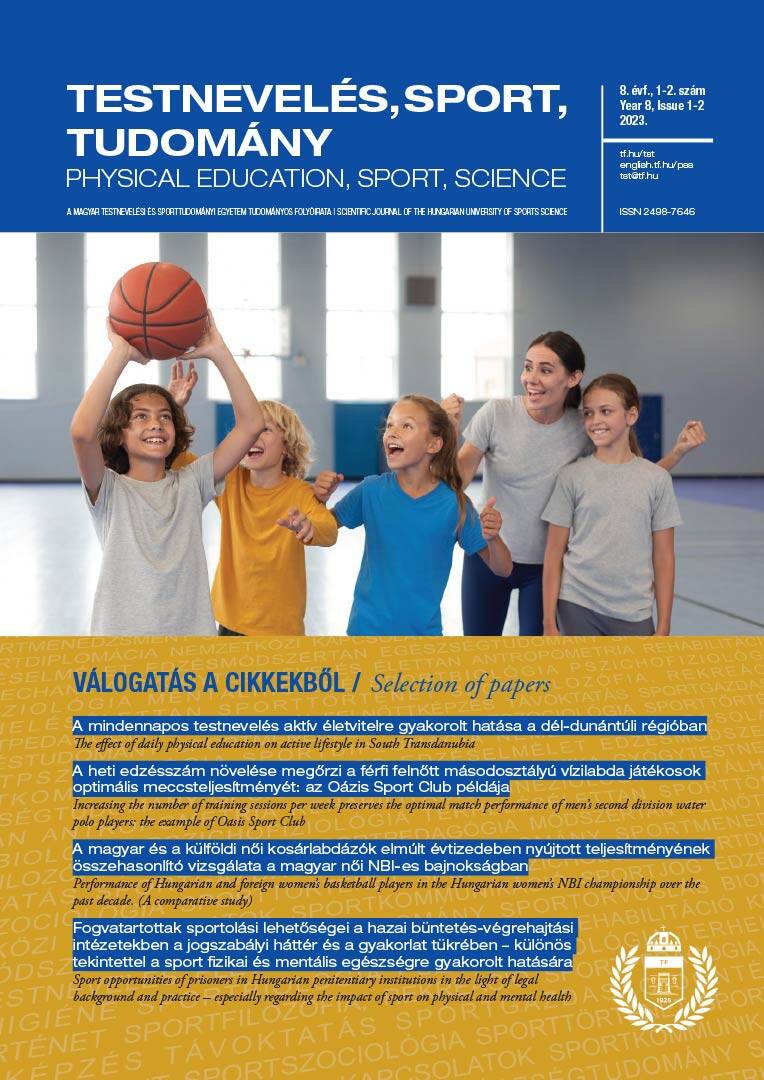
Year 8, Issue 1-2 (2023) >>>
- Foreword
- Original research paper
- Physical Education and Pedagogy
- The effect of daily physical education on active lifestyle in South Transdanubia
Szalai Kata, Csóka László, Máté Éva, Pirisi Gábor, Marton Gergely - Increasing the number of training sessions per week preserves the optimal match performance of men’s second division water polo players: the example of Oasis Sport Club
Gábor Szabó, Dániel Krüzselyi - The importance of compensatory training in water polo by using the example of Oázis SC
Gábor Szabó, Dániel Krüzselyi - Performance of Hungarian and foreign women’s basketball players in the Hungarian women’s NBI championship over the past decade (A comparative study)
Márton Vági, Csilla Filó - Effect of mental training on adolescent artistic swimmers
Borbála Bernadett Zala, László Tóth
- The effect of daily physical education on active lifestyle in South Transdanubia
- Social Sciences
- Sport opportunities of prisoners in Hungarian penitentiary institutions in the light of legal background and practice – especially regarding the impact of sport on physical and mental health
Márta Miklósi - The prevalence and attitudes towards yoga, meditation and relaxation among university students
Zsuzsanna Gép, Krisztina Csókási, Tamás Csányi
- Sport opportunities of prisoners in Hungarian penitentiary institutions in the light of legal background and practice – especially regarding the impact of sport on physical and mental health
- Physical Education and Pedagogy
- PSS+
- Ákos Koller: A brief history of our university’s scientific journals
- News
- Window to the world of sport sciences
- PSS thanks for the reviewers!
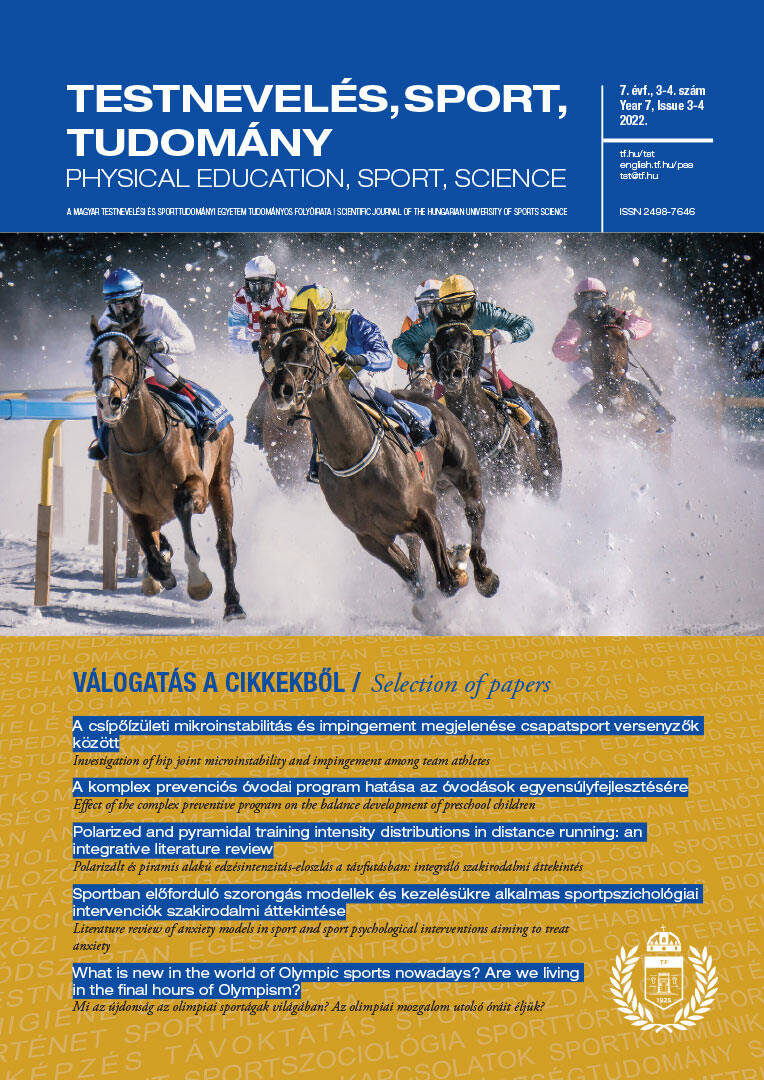
Year 7, Issue 3-4 (2022) >>>
- Foreword
- Original research paper
- Natural Sciences
- Investigation of hip joint microinstability and impingement among team athletes
Krisztián Schandl, Dorottya Tóth, Máté Tóth, Rita Kecskés, Gábor Elbert, Pongrác Ács, Csilla Filó - Effect of the complex preventive program on the balance development of preschool children
Zsolt Csirkés, Orsolya Budai - Polarized and pyramidal training intensity distributions in distance running: an integrative literature review / Polarizált és piramis alakú edzésintenzitás-eloszlás a távfutásban: integráló szakirodalmi áttekintés
Bence Kelemen, Otto Benczenleitner, Laszlo Toth
- Lacza, Szabolcs Molnár, Babak Shadgan, Éva Kőrösi, Márton Jenei, Károly Mensch
- Investigation of hip joint microinstability and impingement among team athletes
- Social Sciences
- Literature review of anxiety models in sport and sport psychological interventions aiming to treat anxiety
Renátó Tóth, László Tóth
What is new in the world of Olympic sports nowadays? (Are we living in the final hours of Olympism?) Clouds on the sky of the Olympic Movement’s future.
András Nemes
- Literature review of anxiety models in sport and sport psychological interventions aiming to treat anxiety
- Natural Sciences
- PSS+
- Gyula Dallos: Introduction of the horse and Hungarian equestrian culture
Attila Sudár: Not what if (after Paris), but what would have to change (before Paris) to win the Olympic gold medal in water polo - Window to the world of sport sciences
- Gyula Dallos: Introduction of the horse and Hungarian equestrian culture
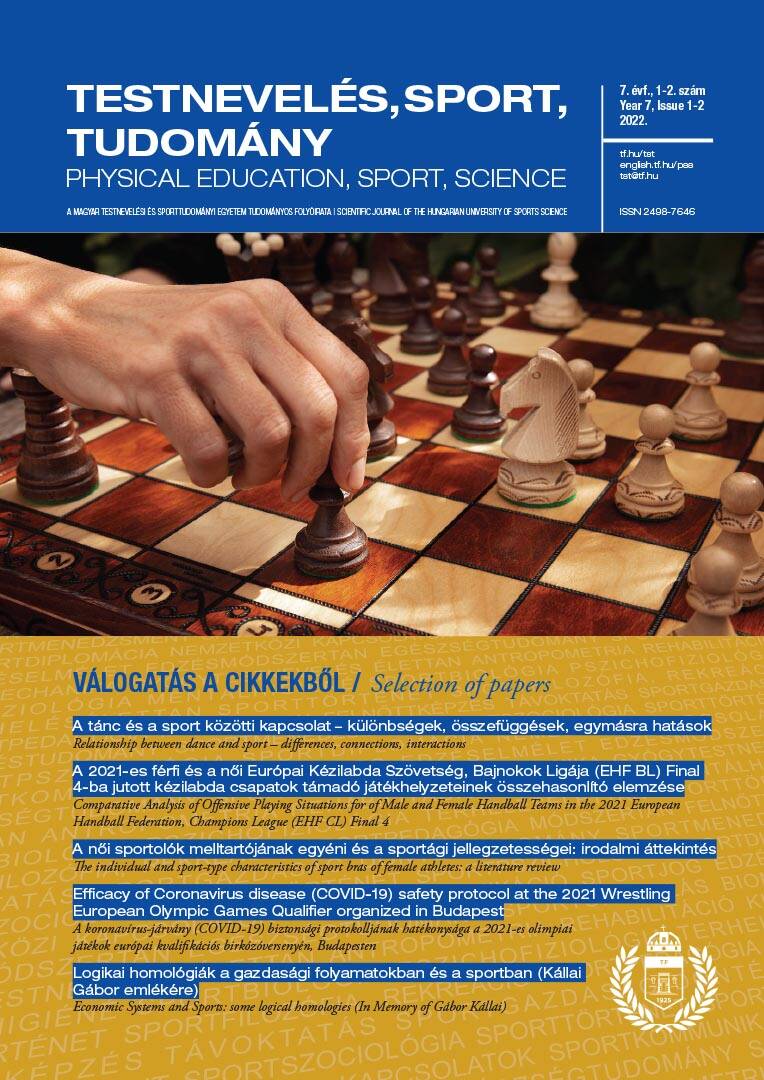
Year 7, Issue 1-2 (2022) >>>
- Foreword
- Original research paper
- Natural Sciences
- Relationship between dance and sport – differences, connections, interactions
Nóra Lezó
- Relationship between dance and sport – differences, connections, interactions
- Sport Sciences
- Comparative Analysis of Offensive Playing Situations for of Male and Female Handball Teams in the 2021 European Handball Federation, Champions League (EHF CL) Final 4
Csaba Ökrös, Dóra Kőnig-Görögh, László Liebscher, Zoltán Lehőcz, Bozsana Fekete, István Csáki - The individual and sport-type characteristics of sport bras of female athletes: a literature review
Imola Nagy, Ákos Koller, Zoltán Béla Debreczeni - Efficacy of Coronavirus disease (COVID-19) safety protocol at the 2021 Wrestling European Olympic
Games Qualifier organized in Budapest
Mira Ambrus, Zsombor Lacza, Szabolcs Molnár, Babak Shadgan, Éva Kőrösi, Márton Jenei, Károly Mensch
- Comparative Analysis of Offensive Playing Situations for of Male and Female Handball Teams in the 2021 European Handball Federation, Champions League (EHF CL) Final 4
- Social Sciences
- Economic Systems and Sports: some logical homologies (In Memory of Gábor Kállai)
István Magas - Science of strategic and tactical decisions in chess
Tamás Sterbenz, Kristóf Világi, Ágoston Koch
- Economic Systems and Sports: some logical homologies (In Memory of Gábor Kállai)
- Natural Sciences
- PSS+
- Ákos Koller: Remembering Gábor Kállai
- Dr. Zsuzsanna Kneffel: Exercise and lifestyle effects in a national and international sample (habilitation summary)
- Dr. Zsombor Lacza: The athlete’s knee - diagnosis of early wear and tear of the knee joint and possibilities for regeneration (habilitation summary)
- Window to the world of sport sciences
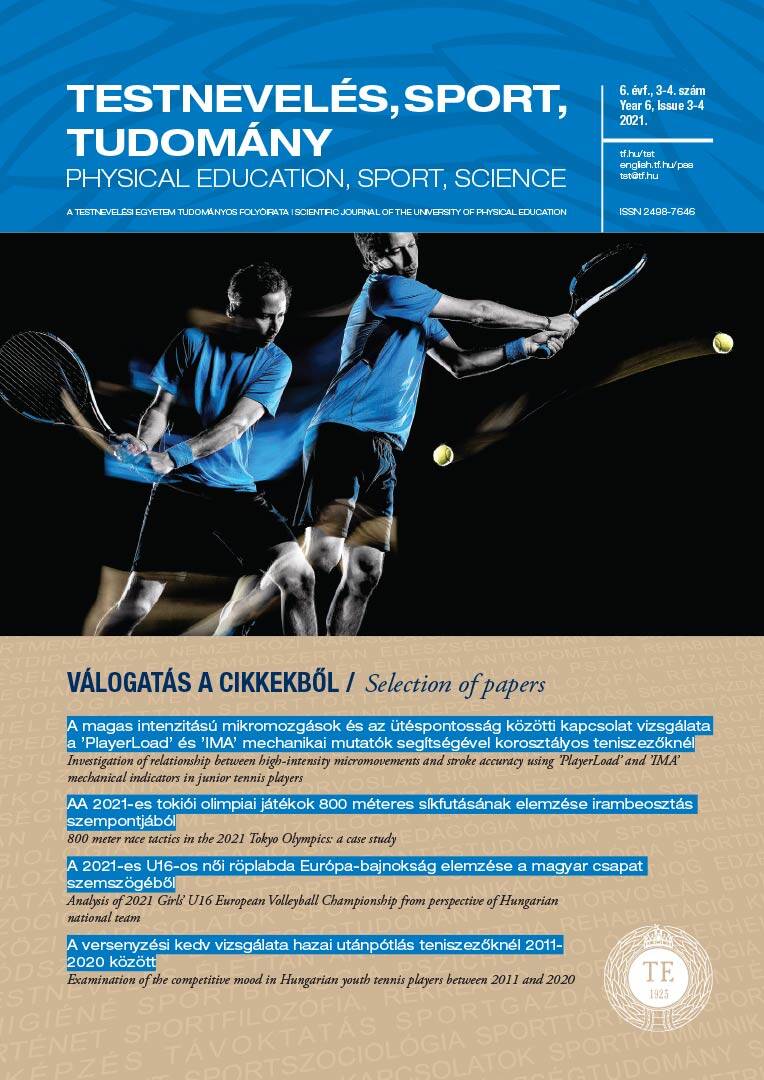
Year 6, Issue 3-4 (2021) >>>
- Foreword
- Pál Hamar: Curriculum theory and sports science
- Original research paper
- Natural Sciences
- Investigation of relationship between high-intensity micromovements and stroke accuracy using ’PlayerLoad’ and ’IMA’ mechanical indicators in junior tennis players
Péter János Tóth, SándorSáfár, Károly Dobos, Dávid Horváth, Tamás Győri, Csaba Ökrös
- Investigation of relationship between high-intensity micromovements and stroke accuracy using ’PlayerLoad’ and ’IMA’ mechanical indicators in junior tennis players
- Sport Sciences
- 800 meter race tactics in the 2021 Tokyo Olympics: a case study
Bence Kelemen, Ottó Benczenleitner, László Tóth - Analysis of 2021 Girls’ U16 European Volleyball Championship from perspective of Hungarian national team
Dóra Kőnig-Görögh, Zoltán Jókay, Tamás Győri, Csaba Ökrös - Examination of the competitive mood in Hungarian youth tennis players between 2011 and 2020
Marcell Dékány, Gábor Pelva, Bence Kopper, Csaba Ökrös
- 800 meter race tactics in the 2021 Tokyo Olympics: a case study
- Natural Sciences
- PSS+
- Ekaterina Glebova: Technological Transformation of Sports Spectators’ Customer Experiences (Doctoral Thesis Summary)
- Defended PhD theses
- Abstracts of the Student Congress on Sport Sciences 2021 of the University of Physical Education
- Window to the world of sport sciences
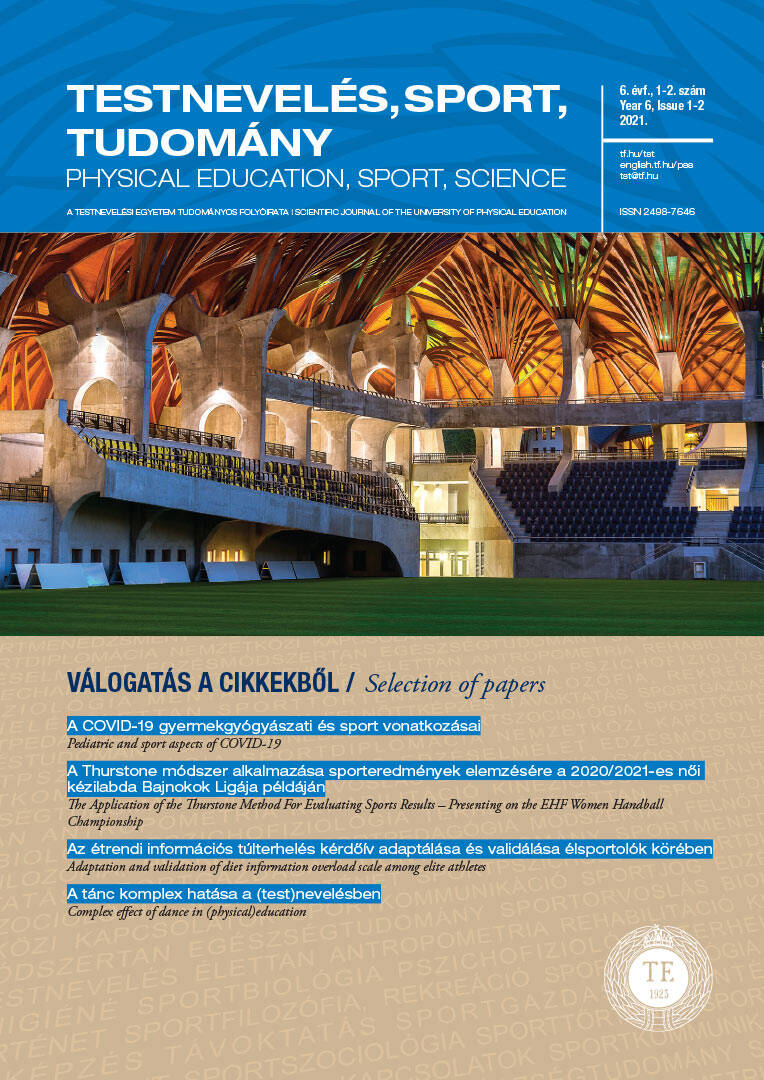
Year 6, Issue 1-2 (2021) >>>
- Foreword
- Original research paper
- Natural Sciences
- Pediatric and sport aspects of COVID-19
Judit Pelle
- Pediatric and sport aspects of COVID-19
- Sport Sciences
- The Application of the Thurstone Method For Evaluating Sports Results – Presenting on the EHF Women Handball Championship
László Gyarmati, Éva Mihálykóné Orbán, Csaba Mihálykó - Adaptation and validation of diet information overload scale among elite athletes
Anna Kiss, Orsolya Tompa, Zoltán Lakner, Sándor Soós - Complex effect of dance in (physical)education
Ákos Molnár, Gyöngyvér Prisztóka
- The Application of the Thurstone Method For Evaluating Sports Results – Presenting on the EHF Women Handball Championship
- Natural Sciences
- PSS+
- Window to the world of sport sciences
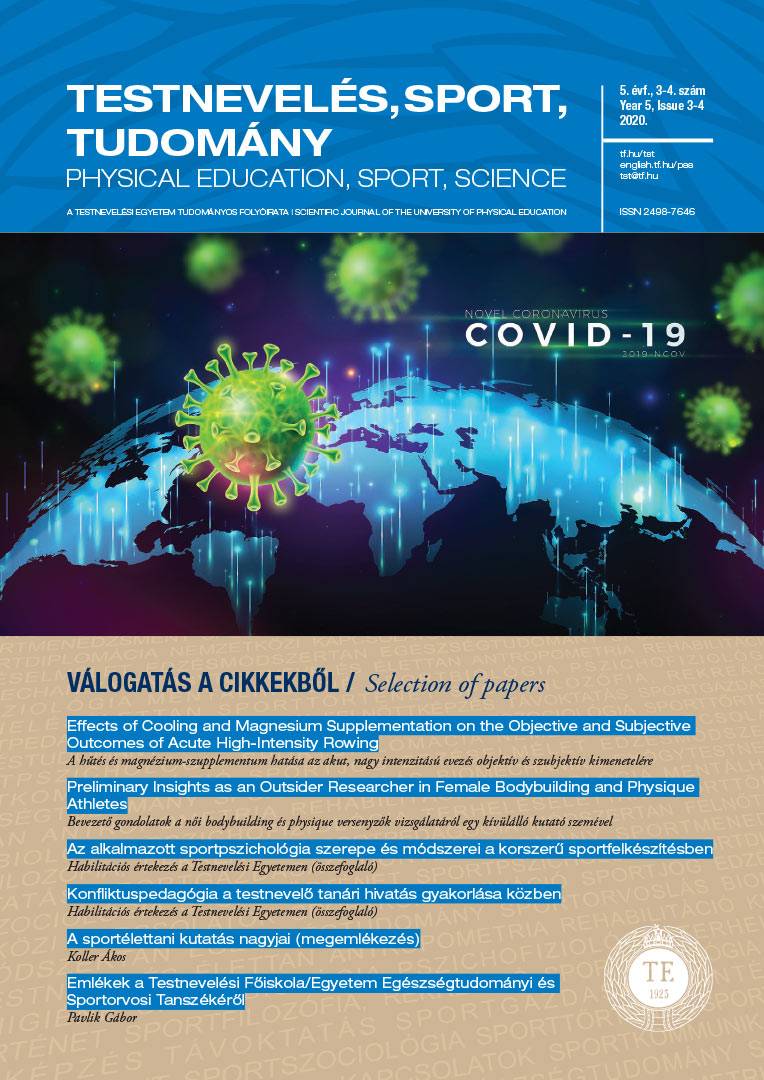
Year 5, Issue 3-4 (2020) >>>
- Foreword
- Original research paper
- Natural Sciences
- Effects of Cooling and Magnesium Supplementation on the Objective and Subjective Outcomes of Acute High-Intensity Rowing
Shu-Ting Li, Jia-Tzer Jang, Akos Koller
- Effects of Cooling and Magnesium Supplementation on the Objective and Subjective Outcomes of Acute High-Intensity Rowing
- Social Sciences
- Preliminary Insights as an Outsider Researcher in Female Bodybuilding and Physique Athletes
Airnel T. Abarra, Tamas Doczi
- Preliminary Insights as an Outsider Researcher in Female Bodybuilding and Physique Athletes
- Natural Sciences
- PSS+
- Habilitation summaries
- Defended PhD theses at the University of Physical Education
- Window to the world of sport sciences

Year 5, Issue 1-2 (2020) >>>
- Foreword
- Original research paper
- Physical Education and Pedagogy
- Science of physical education - Contributions to the scientific-theoretical issues of physical education and sport
Pál Hamar
- Science of physical education - Contributions to the scientific-theoretical issues of physical education and sport
- Sport Sciences
- Critical Moments in Ball Games and the Invisible Mental Dispositions - Citius, altius, fortius
István Magas
- Critical Moments in Ball Games and the Invisible Mental Dispositions - Citius, altius, fortius
- Natural Sciences
- Determining stability of center of gravity in 16-18 year old girls and boys - a pilot study to determine the normal range
László Földvári-Nagy, Gabriella Dörnyei, Ágnes Andrea Mayer, Johanna Takács, Mónika Horváth, Annamária Szénási, Ildikó Balogh, Katalin Lenti
- Determining stability of center of gravity in 16-18 year old girls and boys - a pilot study to determine the normal range
- Social Sciences
- Relocations of Sports Spectators’ Customer Experiences
Ekaterina Glebova, Michel Desbordes, Gabor Geczi - Review on health regulations of international and domestic team sport federations’ with special regard to concussion
Attila Nagy, Csaba Kiss, Anita Boros, Gabor Géczi - Municipal sports affairs – Carrying out the tasks of local governments in relation to sport through municipally owned companies in the light of the audits of the State Audit Office
Anita Boros, Róbert G. Zimányi, Gábor Géczi
- Relocations of Sports Spectators’ Customer Experiences
- Physical Education and Pedagogy
- PSS+
- Habilitation summaries
- Tradition, tradition, heritage - 150 years of the Budapest Skating Club
Eszter Szombathelyi - Window to the world of sport sciences
 Year 4, Issue 3-4 (2019) >>>
Year 4, Issue 3-4 (2019) >>>
- Foreword
- Original research paper
- Sport Sciences
- Analysis of CrossFit Games 2018
Gergely Pálinkás, Petridis Leonidas, Zsófia Tróznai, Katinka Utczás, Bettina Béres, Tamás Szabó
- Analysis of CrossFit Games 2018
- Natural Sciences
- Exploring the relationship between knee injuries and dynamic knee valgus
Ádám Uhlár, Eszter Fodor, Zsombor Lacza
- Exploring the relationship between knee injuries and dynamic knee valgus
- Social Sciences
- The effects of rheumatoid arthritis on Cypriot recreational athletes
Stephen Nicolaou, Efstathios Christodoulides - Cluster analysis of health behavior factors in the Hungarian Defence Forces
Attila Novák, Csaba Nyakas, Zsófia Rázsó, Andrea Sótér - Examination of Hungarian professional ice hockey players’ personality, coping strategies and stress level
Renátó Tóth, Kinga Szabó - Changes in Stadium Sports Spectators Customer Experiences
Ekaterina Glebova, Michel Desbordes, Gabor Geczi
- The effects of rheumatoid arthritis on Cypriot recreational athletes
- Sport Sciences
- PSS+
- World Congress of Sociology of Sport 2019 (ISSA)
Bence Garamvölgyi - International Sport and Innovation Conference 2019 (Program and Abstracts)
- Program of the 49th Conference on Motion Biology
- Defended PhD theses (2019)
- Window to the world of sport sciences
- World Congress of Sociology of Sport 2019 (ISSA)
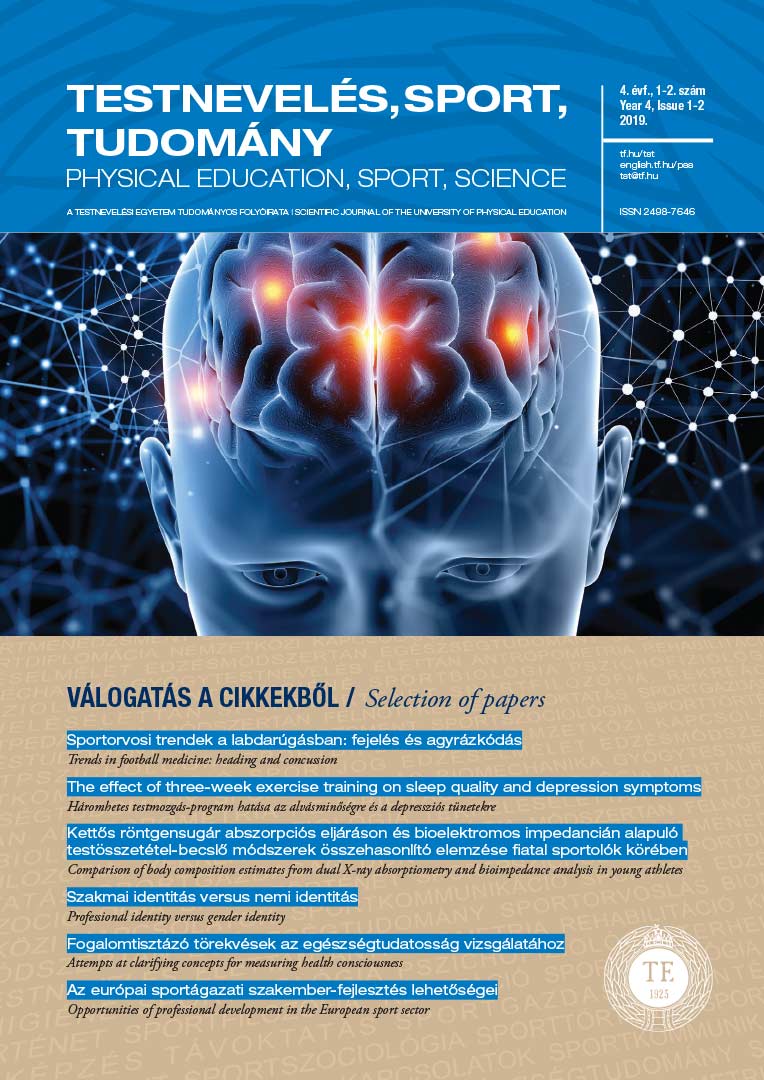 Year 4, Issue 1-2 (2019) >>>
Year 4, Issue 1-2 (2019) >>>
- Foreword
- Original research paper
- Natural Sciences
- Trends in football medicine: heading and concussion
Zsolt Szelid - The effect of three-week exercise programme on sleep quality and depression symptoms in female adults
Johanna Takács - Comparison of body composition estimates from dual X-ray absorptiometry and bioimpedance analysis in young athletes
Katinka Utczás, Zsófia Tróznai, Gergely Pálinkás, Irina Kalabiska, Leonidas Petridis
- Trends in football medicine: heading and concussion
- Social Sciences
- Professional identity versus gender identity: Empirical study among top-level leaders and managers in Hungarian sport
Gyöngyi Szabó Földesi, Andrea Gál - Attempts at clarifying concepts for measuring health consciousness
Tamás Freyer, Dániel Horváth, Ádám Nagy - Opportunities of professional development in the European sport sector: Introducing the ESSA-sport project and its prelimenary results
Nikolette Sipos-Onyestyák, Szilvia Perényi, Judit Farkas, Zsuzsanna Gősi, Erika Kedelényi-Gulyás
- Professional identity versus gender identity: Empirical study among top-level leaders and managers in Hungarian sport
- Natural Sciences
- PSS+
- Abstracts of the Physical Education and Sport Sciences Section of the National Student Congress on Sport Sciences 2019
- Habilitation summaries
- Habilitation summaries
- Konstans kihívások és változó megoldási kísérletek a nők sportjában
Andrea Gál
- Konstans kihívások és változó megoldási kísérletek a nők sportjában
- Window to the world of sport sciences
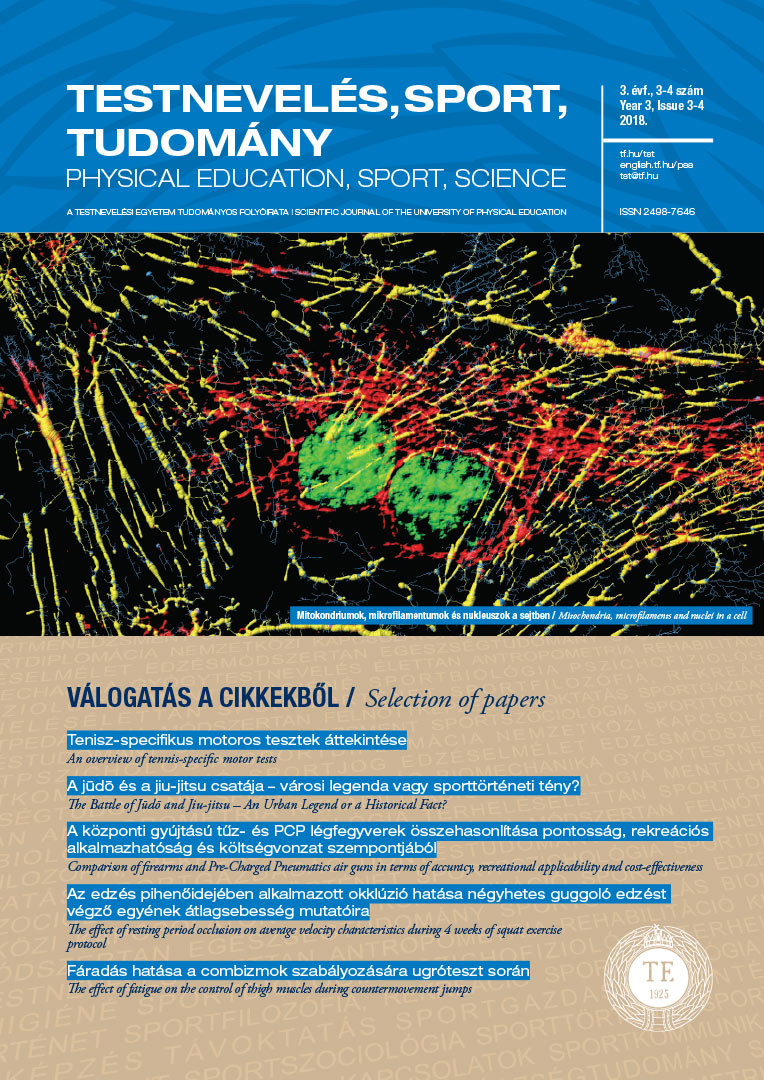 Year 3, Issue 3-4 (2018) >>>
Year 3, Issue 3-4 (2018) >>>
- Foreword
- Original research paper
- Sport Sciences
- Curriculum theory of physical education (Theses of academic doctoral dissertation)
Pál Hamar - An overview of tennis-specific motor tests
Károly Dobos - The Battle of Jūdō and Jiu-jitsu – An Urban Legend or a Historical Fact?
Bendegúz Papp - Comparison of firearms and Pre-Charged Pneumatics air guns in terms of accuracy, recreational applicability and cost-effectiveness
Sándor Béres
- Curriculum theory of physical education (Theses of academic doctoral dissertation)
- Natural Sciences
- The effect of resting period occlusion on average velocity characteristics during 4 weeks of squat exercise protocol
Ferenc Torma, Zoltán Gombos, Péter Bakonyi, Zsolt RadákF - The effect of fatigue on the control of thigh muscles during countermovement jumps
Péter Katona, Ivett Soós
- The effect of resting period occlusion on average velocity characteristics during 4 weeks of squat exercise protocol
- Sport Sciences
- PSS+
- Development of the sport of disabled people in competitive swimming (para swimming) over the last 20 years and experiences of the Rio ParalympicsCsaba Sós
- Remembering Dr. John O. Holloszy
- Abstracts of the Student Congress on Sport Sciences 2018 of the University of Physical Education
- Abstracts of the 23rd International Student Congress on Sport Sciences (ISCSS)
- Program of the 2nd Sport and Innovation International Conference
- Habilitation summaries
- Döntések elméletei és alkalmazásuk a sport gyakorlatában
Tamás Sterbenz - Sport és egészség a társadalmi integráció kontextusában
István Vingender
- Döntések elméletei és alkalmazásuk a sport gyakorlatában
- Defended PhD theses (2018)
- Window to the world of sport sciences
- Development of the sport of disabled people in competitive swimming (para swimming) over the last 20 years and experiences of the Rio ParalympicsCsaba Sós
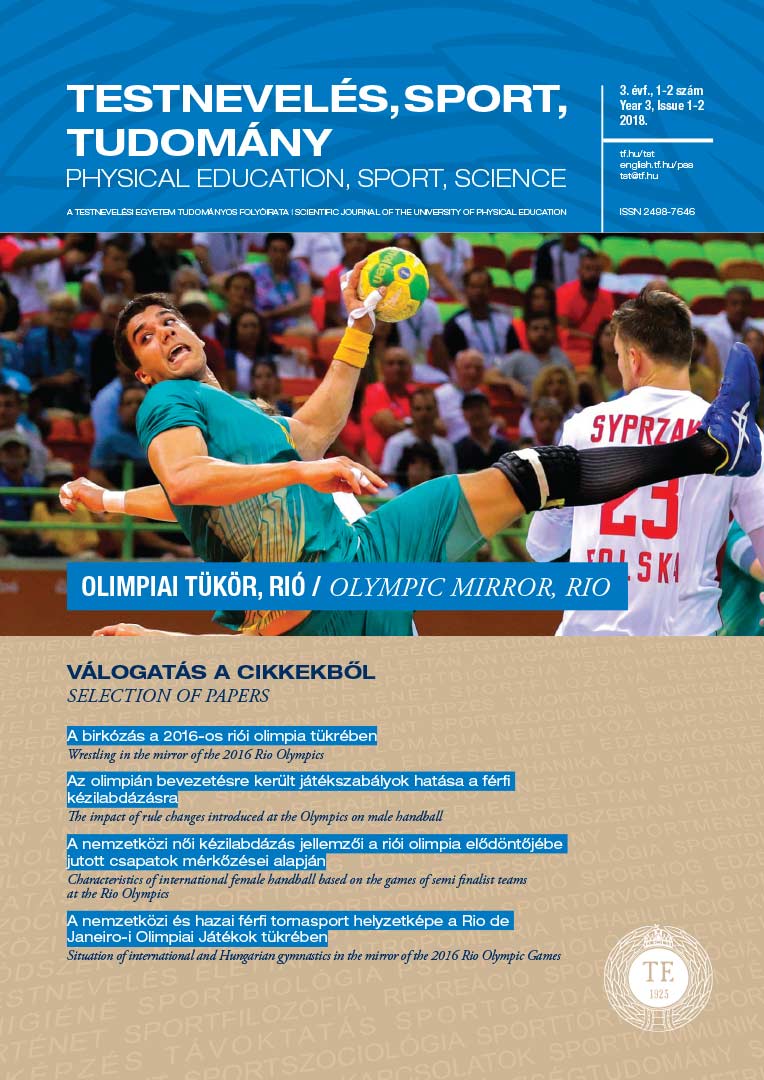 Year 3, Issue 1-2 (2018) >>>
Year 3, Issue 1-2 (2018) >>>
- Foreword
- Original research paper
- Sport Sciences
- Wrestling in the mirror of the 2016 Rio Olympics
Gábor Farkas, Károly Bretz, Tibor Barna - The impact of rule changes introduced at the Olympics on male handball
Zoltán Lehőcz - Characteristics of international female handball based on the games of semi finalist teams at the Rio Olympics
Csaba Ökrös, Gabriella Trzaskoma-Bicsérdy, Tamás Győri - The trends of best results of sprint and jumping events of Track and Field World Championships (1983-2017)
Sándor Béres - Situation of international and Hungarian gymnastics in the mirror of the 2016 Rio Olympic Games
Gergely Gyulai, Steve Butcher, Zsuzsanna Kalmár, István Hamza, Pál Hamar - Comparative analysis of mathes of the Hungarian national futball team at the 2016 European Football Championship
János Tóth jr., János Tóth
- Wrestling in the mirror of the 2016 Rio Olympics
- Social Sciences
- The economic data of sport businesses under the new funding scheme
Zsuzsanna Gősi, József Nagy
- The economic data of sport businesses under the new funding scheme
- Sport Sciences
- PSS+
- Report - Inclusive sports education in integrated pedagogyKatalin Orbán-Sebestyén, Zsuzsanna Szilárd, Krisztina Hunyadi
- Window to the world of sport sciences
- Habilitation summaries
- Nitrogén monoxid szerepe a szívbetegségek kezelésében és a sportban
Zsolt Szelid - A testmozgás és a sportolás lehetőségei megváltozott teljesítőképességgel élő emberek számára
Zsuzsanna Szilárd
- Nitrogén monoxid szerepe a szívbetegségek kezelésében és a sportban
- Report - Inclusive sports education in integrated pedagogyKatalin Orbán-Sebestyén, Zsuzsanna Szilárd, Krisztina Hunyadi
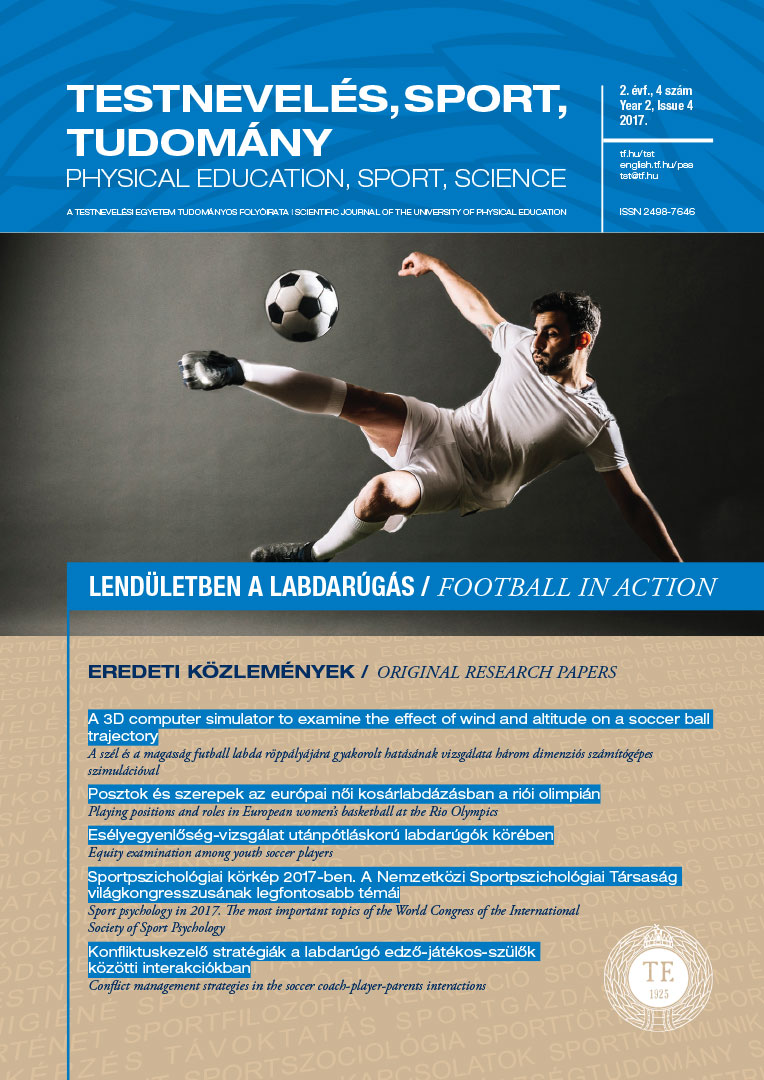
Year 2, Issue 4 (2017) >>>
- Foreword
- Original research paper
- Natural sciences
- A 3D computer simulator to examine the effect of wind and altitude on a soccer ball trajectory
Alexander Egoyan, Ilia Khipashvili, Karlo Moistsrapishvili
- A 3D computer simulator to examine the effect of wind and altitude on a soccer ball trajectory
- Sport Sciences
- Playing positions and roles in European women’s basketball at the Rio Olympics
Judit Balogh
- Playing positions and roles in European women’s basketball at the Rio Olympics
- Social Sciences
- Equity examination among youth soccer players
Péter László Tóth, Tamás Dóczi - Sport psychology in 2017. The most important topics of the World Congress of the International Society of Sport Psychology
Lilla Török, Krisztina Kovács, Noémi Gyömbér, Judit Boda-Ujlaky, Ágota Lénárt - Conflict management strategies in the soccer coach-player-parents interactions
Zsolt Németh
- Equity examination among youth soccer players
- Natural sciences
- PSS+
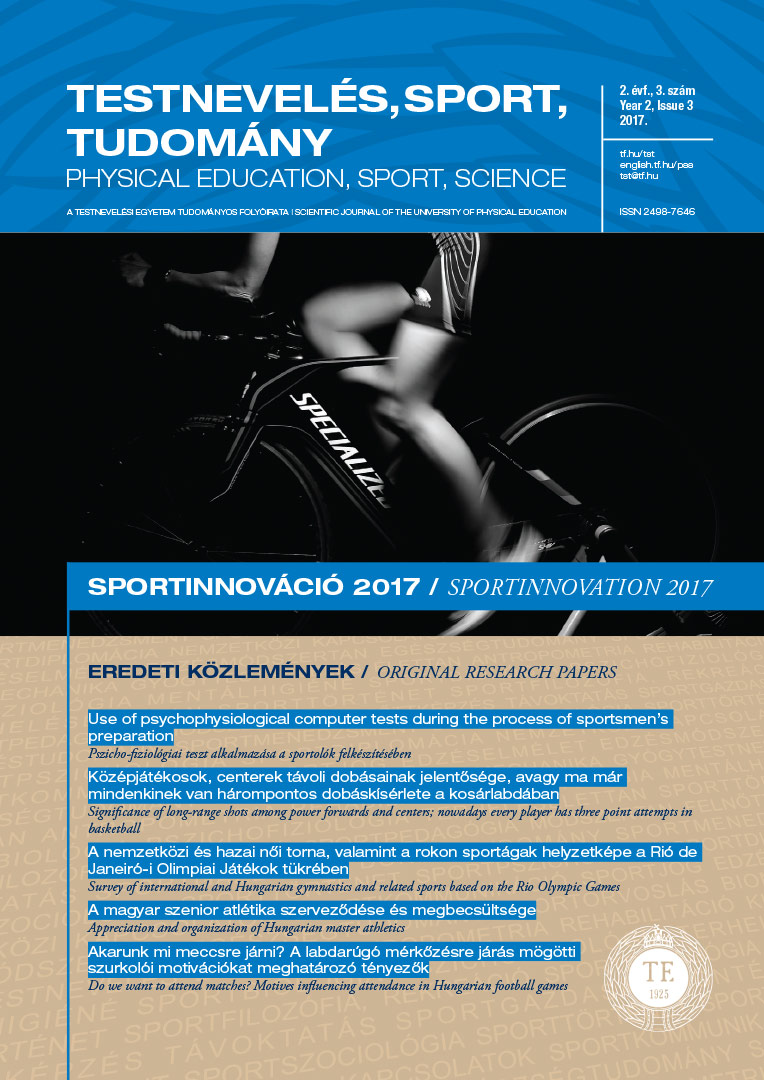
Year 2, Issue 3 (2017) >>>
- Foreword
- Original research paper
- Sport Sciences
- Use of psychophysiological computer tests during the process of sportsmen’s preparation
Alexander Egoyan, Ilia Khipashvili - Significance of long-range shots among power forwards and centers; nowadays every player has three point attempts in basketball
Zoltán Boros, Tamás Sterbenz - Survey of international and Hungarian gymnastics and related sports based on the Rio Olympic Games
Zsuzsanna Kalmár, Gergely Gyulai, Andrea Adorjánné Olajos, Tamás Katus, Pál Hamar - Appreciation and organization of Hungarian master athletics
János Lisztóczki, Ottó Benczenleitner, Sándor Béres
- Use of psychophysiological computer tests during the process of sportsmen’s preparation
- Social Sciences
- Do we want to attend matches? Motives influencing attendance in Hungarian football games
Lili Kassay
- Do we want to attend matches? Motives influencing attendance in Hungarian football games
- Sport Sciences
- Window to the world of sport sciences
- Abstracts of the Student Congress on Sport Sciences 2017 of the University of Physical Education
- Erratum
 Year 2, Issue 1-2 (2017) >>>
Year 2, Issue 1-2 (2017) >>>
- Foreword
- Original research paper
- Physical education and pedagogy
- The idea of modernizing of physical education
Pál Hamar, István Karsai - Task of Adapted PE and its Present Position in Education
Judit Andrásné Teleki - "Sport for Development and Peace" (SDP) as a New Field of Science – a Case Study of a PE development program in Cambodia
Mariann Bardocz-Bencsik,Tamás Dóczi - Leisure-time Activity in Personality Development
Lívia Borosán, Yvette Budainé Csepela - Role of Sport in Afternoon School Activity (in Day Care Centers)
Yvette Budainé Csepela, Lívia Borosán - Measuring Loadability of Secondary School Students during a Teaching Unit of Volleyball
Zsuzsa Nagy, Anetta Müller
- The idea of modernizing of physical education
- Sport sciences
- Measuring Loadability of Secondary School Students during a Teaching Unit of Volleyball
István Juhász, Eszter Boda, Melinda Bíró, Anetta Müller - Analysing Personality of Elite Football Academy Youth Players Compared with Those not Engaged in Competitive Sports
Zoltán Kiss, István Csáki, Barbara Fózer-Selmeci, József Bognár - Role of Small-sided Games in Football Conditioning
Károly Papp, Lajos Szekeres, János Tóth jr., János Tóth - Analysis of 2016 European Football Championships in Relation to Successful Short-, Medium- and Long-range Passes
József Berta, JánosTóth jr., János Tóth
- Measuring Loadability of Secondary School Students during a Teaching Unit of Volleyball
- Social sciences
- Sports – Financing – Success?
Kinga Ráthonyi-Odor, Attila Borbély - Success of 2016 Rio Olympic Games as Reflected in the Income of Sport Organizations
Zsuzsanna Gősi - Assessing Effects of the TAO System on Hungarian Basketball Teams
Péter Váczi, Eszter Boda, Judit Herpainé Lakó, Anetta Müller - Chances of Dual Career Development in Sport in Hungary
Judit Farkas, Mátyás Jókai, Tibor Kozsla - Role of Social Network and Social Support in Sporting Motivation of Prospective Teachers
Tamás Pinczés, Bettina Pikó - Intention of Applying Systems Rationalizing Sport Selection of Youth
Péter Soldos - Personal Training and Health Promotion at Workplaces - Meeting of Theory and Practice
Zoltán Tánczos, József Bognár - Performance Strategies and State of Mood in Two University Basketball Teams
István Soós, Jose Carlos Flores Martinez, Pál Hamar, Zsuzsanna Kalmár, Ian Whyte, Attila Szabó
- Sports – Financing – Success?
- Natural sciences
- Recording Trajectory of Upper-Body Coordination and Pressure Centre Points in Wheelchair Patients with Muscle Dystrophy
Erika Medveczky, Piroska Szalay, Csaba Nyakas, Károly Bretz - Subjective Well-being of Sporting and Non-sporting Adolescents
Zalán Négele, Júlia Pápai, Zsófia Tróznai, Csaba Nyakas - Developing Static and Dynamic Equilibrium of 8-9 Year Old Girls with Hippotherapy
Ágnes Simon-Ugron - Equilibrium Development of Hearing-impaired Children with Playful Movement Programs
Ágnes Simon-Ugron, Iuliana Boros-Bálint
- Recording Trajectory of Upper-Body Coordination and Pressure Centre Points in Wheelchair Patients with Muscle Dystrophy
- Physical education and pedagogy
- Book review
- Sport and Social Sciences with Reflection on Practice
Tamás Dóczi
- Sport and Social Sciences with Reflection on Practice
- Window to the world of sport sciences
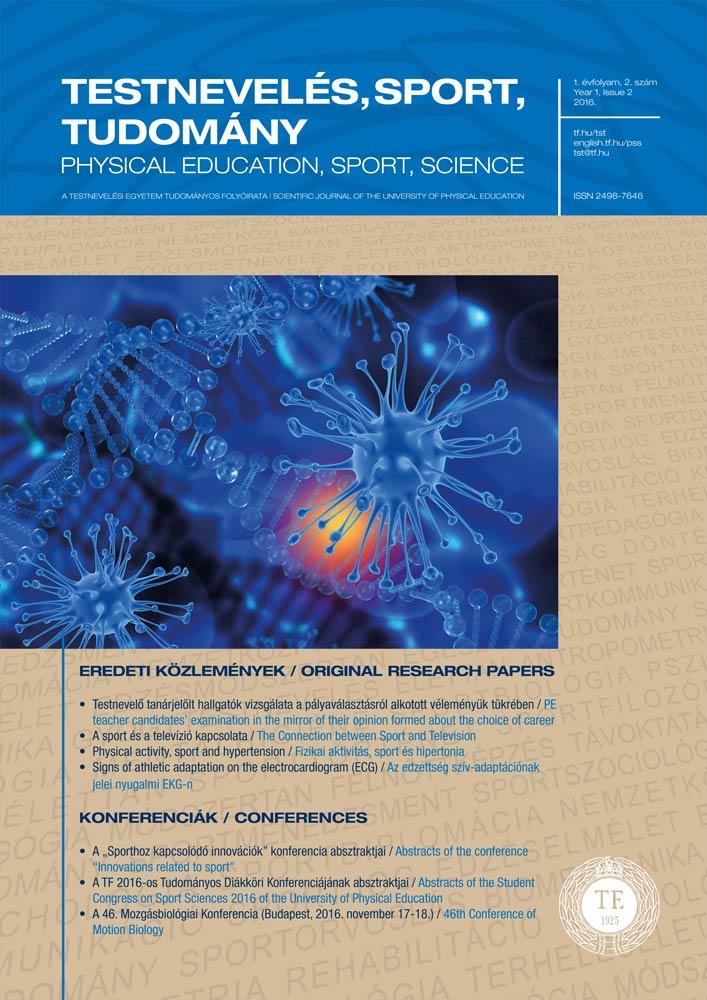
Year 1, Issue 2 (2016) >>>
- Foreword
- Original research paper
- Physical education and pedagogy
- PE teacher candidates’ examination in the mirror of their opinion formed about the choice of career
Ádám Uhlár, Ágnes Szemes, LászlóTóth
- PE teacher candidates’ examination in the mirror of their opinion formed about the choice of career
- Social sciences
- The Connection between Sport and Television
Ferenc Várhegyi
- The Connection between Sport and Television
- Natural sciences
- Physical activity, sport and hypertension
István Préda - Signs of athletic adaptation on the electrocardiogram (ECG)
Zsolt Szelid
- Physical activity, sport and hypertension
- Physical education and pedagogy
- Conferences
- Abstracts of the conference "Innovations related to sport"
- Abstracts of the Student Congress on Sport Sciences 2016 of the University of Physical Education
- 46th Conference of Motion Biology (Budapest, november 17-18, 2016)
- Windows to the World of Science
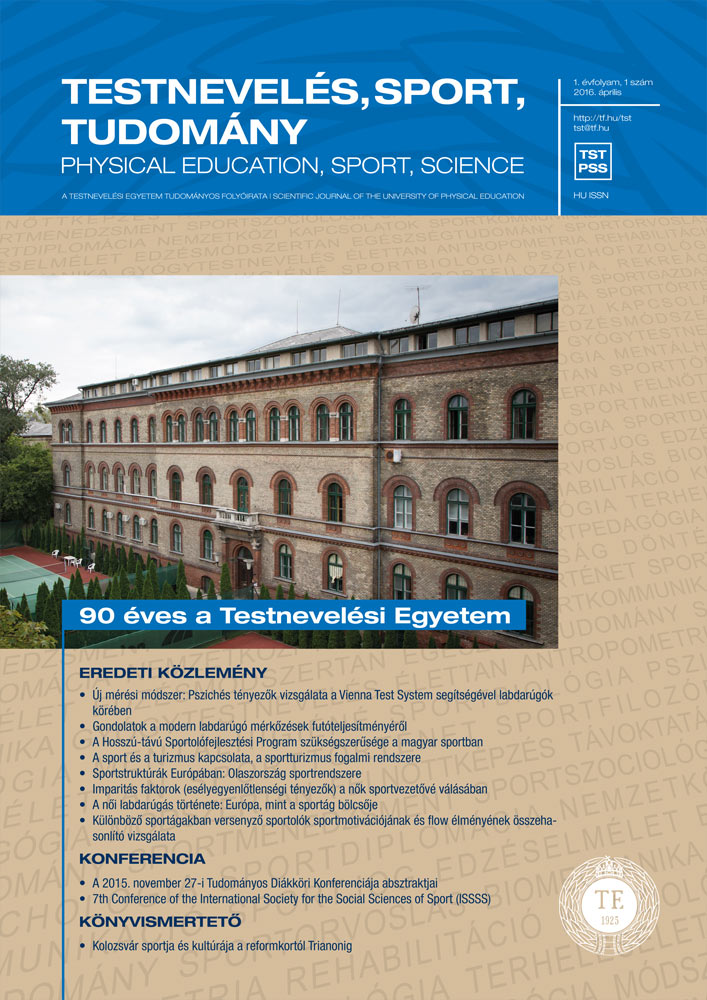 Year 1, Issue 1 (2016) >>>
Year 1, Issue 1 (2016) >>>
- Foreword
- Original research paper
- Physical education and pedagogy
- New measurement method: Examination of psychological factors with Vienna System among soccer players
István Csáki, Barbara Fózer-Selmeci, József Bognár, Péter Szájer, Dávid Zalai, Gábor Géczi, László Révész, LászlóTóth
- New measurement method: Examination of psychological factors with Vienna System among soccer players
- Practical sport sciences
- Thoughts on running performance at modern soccer matches
Dávid Zalai, Zsolt Gyimes, Péter Bobák, István Csáki, Pál Hamar - Necessity of Long-Term Athlete Development in Hungarian sport
Gábor Géczi, István Baji
- Thoughts on running performance at modern soccer matches
- Social sciences of sport
- The Connection between Sport and Tourism, the Conceptual System of Sport Tourism
Dóra Lasztovicza, Piroska Béki - Structures of Sport in Europe: the Sport System of Italy
Péter Farkas, Barbara Rácz - Imparitas factors (gender inequality factors) in relation to women’s sportleadership
Magdolna Trenka - The history of women’s football: Europe, the cradle of this sport
Diána Déri - Comparative study of sportmotivation and flow-experience in different sport competitors
Ágnes Szemes, Szabolcs Gergő Harsányi, László Tóth
- The Connection between Sport and Tourism, the Conceptual System of Sport Tourism
- Physical education and pedagogy
- Conferences
- Abstracts of the Student Congress on Sport Sciences 2015 of the University of Physical Education
- 7th Conference of the International Society for the Social Sciences of Sport (ISSSS) "Sport in changing social, economic, political and cultural contexts"
The purpose of TST/PSS is to publish high standard articles in the Hungarian and English languages, in the field of basic sport sciences, and those related to the applied research of sports professionals. The journal promotes the publication of original research articles, review articles and book reviews, and provides a forum for the abstracts of scientific conferences organised at the University of Physical Education, Budapest, Hungary. Original and review articles will go through a peer-review process (independent, double-blind reviews); book reviews are to be published by invited authors.
General formal requirements
Manuscripts should be submitted in Garamond font, size 11 (or Times New Roman if Garamond is unavailable), with simple line spacing. The title should be clear, informative and attention-catching, with a maximum of twenty words. After this, a Hungarian and an English abstract should follow (foreign authors can have their English abstract translated by the editorial staff). Manuscripts should be prepared unformatted; formatting of the text is done by the editorial staff. Manuscripts should be sent in MS Word and PDF format as well. Language proofreading is recommended, but will also be done by the editorial staff.
Abstract
The maximum limit of the abstract in Hungarian and English is 250 words each, with no paragraph divisions and no highlighting. Since abstracts can be included in international data bases, their careful preparation is of crucial importance. Authors should complement their abstracts with 4-6 keywords in both languages, considering the use of words which are different from those in the title.
Structure
In the case of longer articles, it is recommended to divide them into chapters and subchapters. Titles of chapters should appear in bold letters; those of the sub-chapters should appear in italics. It is more reader-friendly if the text is divided into paragraphs. The paragraphs should generally contain multiple sentences and not be longer than one typed page. Paragraphs do not need to be separated by extra spacing.
Tables
Tables should use Arabic numbers. Each table must have a title (with bold letters), displayed at the top of the table. In the text, tables should be referred to by their numbers. Owing to the potential changes made during the page-setting process, the use of words indicating directions (e.g. following, previous, above, below, etc.) should be avoided. Tables should be accompanied with a legend, comprehensive, and understandable independent of the text. Tables with more complex or less informative data can be supplemented with notes. The layout of the journal must be taken into consideration when preparing the tables (maximum width: 157 mm).
Figures
Arabic numbers should be used in the figures as well. Each figure must have a title (with bold letters) displayed below the figure, not included in the drawing. In the text, figures should be referred to by their numbers. Figures should be labelled and accompanied with a legend, comprehensive, and understandable independent of the text. The Editorial Board of TST/PSS only accepts figures of high quality. The layout of the journal must be taken into consideration during the preparation of the figures (maximum width: 157 mm). Figures should be sent (1) in the text, in their appropriate place as considered by the author, and (2) in separate files as well. Files should be sent in vector format so that the size can be altered without a reduction in quality. If only image format (JPG, PNG) is available, it should be 300 DPI in the planned size of the figure. If DPI checking is not possible, then pixel size can be calculated based on the following formula: P/300*25.4 (where P is the size of the picture in pixels)– this allows a determination of what maximum size the digital content available can take up in the publication. For example, if we have a picture with a width of 2,000 pixels, it can be maximum 2000/300*2.54=169.33 mm wide in printing. Any size alteration will reduce quality (this is why the vector format is more practical).
The legal use of previously published figures is the responsibility of the author. Regarding this, simply referring to the source may not be sufficient. Any online or offline (printed) figures are protected by copyright, unless the owner disclaims otherwise. Therefore, in the case of figures from other sources, we ask the author to attach their written consent regarding re-publishing.
Footnotes
Footnotes are mainly for remarks related to the text. The length of one footnote should not exceed five typed lines. Minimizing the number and length of the footnotes and including remarks in the main text is advised. Footnotes should be used where the continuity of the main text would otherwise be broken. Footnotes can be used for citing unpublished materials, documents from archives, and other notes. In print, footnotes will appear on the page in which the reference is made.
References
In the text, references should follow APA style (6th dition). Names of authors should be displayed in italics. The list of references is to be placed at the end of the manuscript in alphabetical order with the name of the first author, also in accordance with APA 6th edition guidelines. Publications of the same author must be put in chronological order. Every reference in the text must appear in the list of references, and vice versa. In special cases, the author can provide additional recommended readings. The DOI number of articles should be included all references.
Acknowledgements, conflicts of interest
The author can publicly express gratitude, referring to the origin of the study, the research topic, individual or institutional assistance, funding, etc. Acknowledgements should be placed between the text and the reference list. Any conflicts of interest, whether explicit or implicit, must be indicated by the author.
Author’s address
The (first) author should provide affiliation (institute, faculty, department), address, telephone number and email address to be published so can be contacted.
Physical Education, Sport, Science - Official scientific journal of the Hungarian University of Sports Science, Budapest, Hungary | Published online 4 times in a year | Peer-reviewed journal: the manuscripts are reviewed by two independent experts.
Editorial office and publisher: Hungarian University of Sports Science. Address: Alkotás u. 42-48., Budapest, 1123 Hungary | Phone: +36-1-487-9213 | E-mail:
All rights reserved. The publisher does not take responsibility for the content of advertisements. The publishing rights of all written and visual materials belong to the publisher; to make a copy of the issue or any part of it is required to ask for the permission of the publisher.
ISSN 2498-7646
Editor-in-chief
- Ákos Koller (Natural Sciences)
Editors
- Lajos Mocsai (Sport Sciences)
- Pál Hamar (Physical Education and Pedagogy)
- Tamás Sterbenz (Social Sciences)
Editorial staff
- Tamás Dóczi
- Bettina Béres
- Lilla Török
Language proofreader
- Krisztina Nemerkényi-Hidegkuti
Design and prepress
- András Király
Editorial board
- Pongrác Ács / University of Pécs (HU)
- László Balogh / University of Debrecen (HU)
- Attila Borbély / Wekerle Business School, Budapest (HU)
- Stansislaw Czyz / North West University, Potchefstroom (ZA)
- Dirk Duncker / Erasmus MC, Rotterdam (NL)
- Andrea Gál / University of Physical Education, Budapest (HU)
- Gábor Géczi / University of Physical Education, Budapest (HU)
- Rita Józsa / University of Pécs (HU)
- Katalin Keresztesi / University of Debrecen (HU)
- Erika Koltai / University of Physical Education, Budapest (HU)
- József Laczkó / University of Pécs (HU)
- Ádám Lelbach / Dr. Rose Hospital, Budapest (HU)
- Helena Lenasi / University of Ljubljana (SI)
- Béla Merkely / Semmelweis University (HU)
- Davor Milicic / University Hospital Centre Zagreb (CR)
- Szilvia Perényi / University of Physical Education, Budapest (HU)
- Petridis Leonidas / University of Physical Education, Budapest (HU)
- István Préda / Military Hospital, Budapest (HU)
- László Révész / Eszterházy Károly University, Eger (HU)
- István Soós / University of Sunderland (UK)
- László Tóth / University of Physical Education, Budapest (HU)
- Márta Wilhelm / University of Pécs (HU)
Advisory board
- István Berkes / University of Physical Education, Budapest (HU)
- Gyöngyi Szabó Földesi / University of Physical Education, Budapest (HU)
- János Gombocz / University of Physical Education, Budapest (HU)
- Gábor Pavlik / University of Physical Education, Budapest (HU)
- Kornél Sipos / University of Physical Education, Budapest (HU)
- József Tihanyi / University of Physical Education, Budapest (HU)
- Ákos Tóth / University of Physical Education, Budapest (HU)
- Krisztina Nemerkényi-Hidegkuti / University of Physical Education, Budapest (HU)
The conference on monday, 11 July 2016 covered wide range of topics within sport sciences. It provided ample opportunities for oral and poster presentations for the young researchers to gain valuable feedback from the community and establish new collaborations and joint research projects among the participants.
Programme
9.30 Opening ceremony. Welcome: Prof. Zsolt Radák
10.00-12.10 Oral session. Chairs: Prof. Zsolt Radák (University of Physical Education), Prof. Mitsuru Higuchi (Waseda University)
- 10.00 – 10.25 Invited lecturer: Prof. Suzuki Katsuhiko (Waseda Univesity, Japan) Cytokine response to exercise
- 10.25 – 10.40 Oluwaseyi Olubunmi Sodiya (University of Malaya, Malaysia): Pilot Study on Effects of Demonstration Method During the Teaching of Soccer Dribbling Skill to 8 Years Old Children
- 10.40 – 10.55 Singh Pramod Kumar (T N Sports and Physical University, India)
- 10.55 – 11.10 Kondo Saki (Waseda University, Japan): Pre-exercise Ingestion of Carbodydrate Does Not Induce Hypoglycemaia During Cycling Exercise in Japanese Men
- 11.10 -11.25 Hiroko Murata (Waseda University, Japan): Decreasing Cardiometabolic Risk by Dietary Counseling Intervention in Heavyweight Judo Athletes
- 11.25 – 11.40 Tabata Hiroki (Waseda University, Japan): Effect of Aging on Sex Differences in Fat Oxidation
- 11.40 – 11.55 Erika Koltai (University of Physical Education, Hungary: Novel Role of Sirtuin Related Mechanisms in Overload-Induce Hypertrophy of Sceletal Muscle in Rat
- 11.55 – 12. 10 Dóra Ábrahám (University of Physical Education, Hungary): How Interval Training and Probiotic Supplementation Affects the Cognitive Function in Transgenic Mice Model of Alzheimer’s Disease
12.10 – 12.30 Coffee break
12.30-12.55 Poster session. Chairs: Prof. Zsolt Radák (University of Physical Education), Prof. Mitsuri Higuchi (Waseda University)
- 12.30 – 12.35 Yunah Jeon (Korea National Sport University, Korea): Effect of Aerobic Exercise Training on NADPH Oxidase Activity in Muscle Microvasular Endothelial Function in Aged Men
- 12.35 – 12.40 Yeo Hyoseong (Korea National Sport University, Korea): Endurance Exercise Training Regulates Mitochondrial Biogenesis in Skeletal Muscle of Diabetic Mice
- 12.40 – 12.45 Lim Chang Hyun (Korea National Sport University, Korea): Effect of Different Dose of Leucin Ingestion follow Resistance Exercise on Satellite Cell Activation of Skeletal Muscle in Rats
- 12.45 – 12.50 Nishimaki Mio (Waseda University, Japan): Effects of Different Weight-Loss Periods on Oxidative Stress State in Collegiate Wrestlers
- 12.50 – 12.55 Ra Seung Goo (Chon Buk National University, Korea)
13.10 Closing ceremony and lunch

